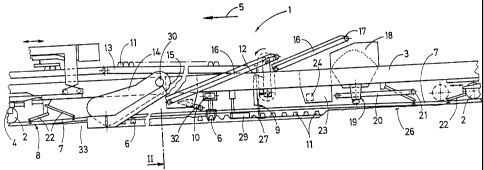Some of the information on this Web page has been provided by external sources. The Government of Canada is not responsible for the accuracy, reliability or currency of the information supplied by external sources. Users wishing to rely upon this information should consult directly with the source of the information. Content provided by external sources is not subject to official languages, privacy and accessibility requirements.
Any discrepancies in the text and image of the Claims and Abstract are due to differing posting times. Text of the Claims and Abstract are posted:
| (12) Patent: | (11) CA 2570586 |
|---|---|
| (54) English Title: | METHOD FOR REPLACING OLD SLEEPERS OF A RAILWAY TRACK BY NEW SLEEPERS |
| (54) French Title: | PROCEDE POUR REMPLACER D'ANCIENNES TRAVERSES D'UNE VOIE DE CHEMIN DE FER PAR DE NOUVELLES TRAVERSES |
| Status: | Deemed expired |
| (51) International Patent Classification (IPC): |
|
|---|---|
| (72) Inventors : |
|
| (73) Owners : |
|
| (71) Applicants : |
|
| (74) Agent: | RICHES, MCKENZIE & HERBERT LLP |
| (74) Associate agent: | |
| (45) Issued: | 2013-03-12 |
| (86) PCT Filing Date: | 2005-05-18 |
| (87) Open to Public Inspection: | 2006-01-26 |
| Examination requested: | 2009-12-01 |
| Availability of licence: | N/A |
| (25) Language of filing: | English |
| Patent Cooperation Treaty (PCT): | Yes |
|---|---|
| (86) PCT Filing Number: | PCT/EP2005/052284 |
| (87) International Publication Number: | WO2006/008202 |
| (85) National Entry: | 2006-11-29 |
| (30) Application Priority Data: | ||||||
|---|---|---|---|---|---|---|
|
The aim of the invention is to replace old ties (6) of a railway track (8) by
new ties (11). This aim can be achieved by spreading the two rails (7) apart
from each other. The reception of ballast gravel (26) for producing a recess
of ballast is carried out in a region below of the sleeper head (25) of a
ballast bed (33), which is located adjacent to the region of the old sleepers
(6) along their longitudinal axis. The received ballast gravel is temporarily
stored and, once the new sleepers (11) have been deposited, thrown off for the
purpose of ballasting. In parallel and prior to the deposit of new sleepers
(11), excess ballast gravel (26) is ploughed in the recess of ballast so as to
produce a levelled surface of ballast (27).
L'objectif de l'invention est de déplacer d'anciennes traverses (6) d'une voie de chemin de fer (8) par de nouvelles traverses (11). A cet effet, les deux rails (7) sont écartés l'un de l'autre. La réception de ballasts (26) destinés à produire une cavité pour un lit est réalisée dans une partie tête avant (26) des traverses d'un lit de ballasts placé sur les anciennes traverses (6) dans le sens de la longueur des traverses. Le ballast est ensuite stocké, puis il est retiré en fonction de la mise en place des nouvelles traverses (11) en vue d'un ballastage. Avant la mise en place des nouvelles traverses (11), des ballasts en surplus (26) sont labourés dans la cavité du lit, de manière à produire un palier de voies (27) de ballasts.
Note: Claims are shown in the official language in which they were submitted.
Note: Descriptions are shown in the official language in which they were submitted.

For a clearer understanding of the status of the application/patent presented on this page, the site Disclaimer , as well as the definitions for Patent , Administrative Status , Maintenance Fee and Payment History should be consulted.
| Title | Date |
|---|---|
| Forecasted Issue Date | 2013-03-12 |
| (86) PCT Filing Date | 2005-05-18 |
| (87) PCT Publication Date | 2006-01-26 |
| (85) National Entry | 2006-11-29 |
| Examination Requested | 2009-12-01 |
| Correction of Dead Application | 2010-03-15 |
| (45) Issued | 2013-03-12 |
| Deemed Expired | 2020-08-31 |
There is no abandonment history.
| Fee Type | Anniversary Year | Due Date | Amount Paid | Paid Date |
|---|---|---|---|---|
| Registration of a document - section 124 | $100.00 | 2006-11-29 | ||
| Application Fee | $400.00 | 2006-11-29 | ||
| Maintenance Fee - Application - New Act | 2 | 2007-05-18 | $100.00 | 2006-11-29 |
| Maintenance Fee - Application - New Act | 3 | 2008-05-20 | $100.00 | 2008-04-17 |
| Maintenance Fee - Application - New Act | 4 | 2009-05-19 | $100.00 | 2009-04-17 |
| Request for Examination | $800.00 | 2009-12-01 | ||
| Maintenance Fee - Application - New Act | 5 | 2010-05-18 | $200.00 | 2010-04-16 |
| Maintenance Fee - Application - New Act | 6 | 2011-05-18 | $200.00 | 2011-04-18 |
| Maintenance Fee - Application - New Act | 7 | 2012-05-18 | $200.00 | 2012-04-17 |
| Final Fee | $300.00 | 2012-11-09 | ||
| Maintenance Fee - Patent - New Act | 8 | 2013-05-21 | $200.00 | 2013-04-26 |
| Maintenance Fee - Patent - New Act | 9 | 2014-05-20 | $200.00 | 2014-04-23 |
| Maintenance Fee - Patent - New Act | 10 | 2015-05-19 | $250.00 | 2015-04-27 |
| Maintenance Fee - Patent - New Act | 11 | 2016-05-18 | $250.00 | 2016-04-15 |
| Maintenance Fee - Patent - New Act | 12 | 2017-05-18 | $250.00 | 2017-04-19 |
| Maintenance Fee - Patent - New Act | 13 | 2018-05-18 | $250.00 | 2018-04-16 |
| Maintenance Fee - Patent - New Act | 14 | 2019-05-21 | $250.00 | 2019-04-09 |
Note: Records showing the ownership history in alphabetical order.
| Current Owners on Record |
|---|
| FRANZ PLASSER BAHNBAUMASCHINEN-INDUSTRIEGESELLSCHAFT MBH |
| Past Owners on Record |
|---|
| BRUNNINGER, MANFRED |
| THEURER, JOSEF |